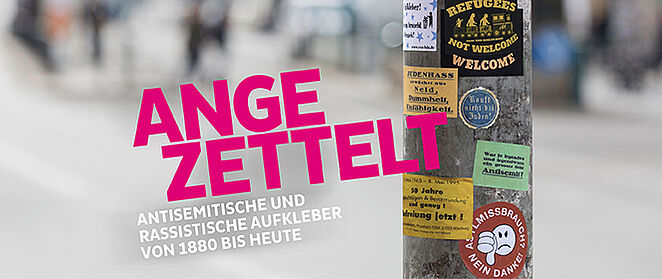Sticky Messages
Antisemitic and racist stickers from 1880 to the present

20 April to 31 July 2016
They are familiar to everyone and can be found sticking everywhere: on street signs, letter boxes, in underground stations, in children's rooms, in love letters. Stickers and adhesive labels, also known as sticky notes, have been around on a massive scale since the late 19th century: a small format that is zealously disseminated in public places, privately collected and often traded. Stickers have been used since the beginning as an inexpensive way of popularising worldviews. Collector cards and albums helped to spread and reinforce racist ideas of inequality and superiority and to bring them into people's private lives. Stickers with anti-Jewish pictures and slogans have always been extremely popular with antisemites. But Jewish organisations soon learned to fight back against these slanderous attacks and publicly combated the antisemitic propaganda. Even today stickers are used for political agitation. Stickers like "Refugees welcome" or "Nein zum Heim" – short for saying "we don't want any refugees living here" – serve to signal acceptance, to polarise or to intimidate people.
The exhibition "Sticky Messages. Antisemitic and racist stickers from 1880 to the present" shows adhesive notes, trading cards and pictures, letter sealers and stickers from the German Empire, the Weimar Republic, National Socialism and on into the present day in their respective context. "Sticky Messages" tells of a social practice of misanthropic prejudices and recounts at the same time the history of fighting against antisemitic and racist stereotypes.
Additional Information
Exhibition flyer
Download (PDF)
An exhibition of the Center for Research on Antisemitism at Technische Universität Berlin and the Deutsches Historisches Museum
Funded by the

